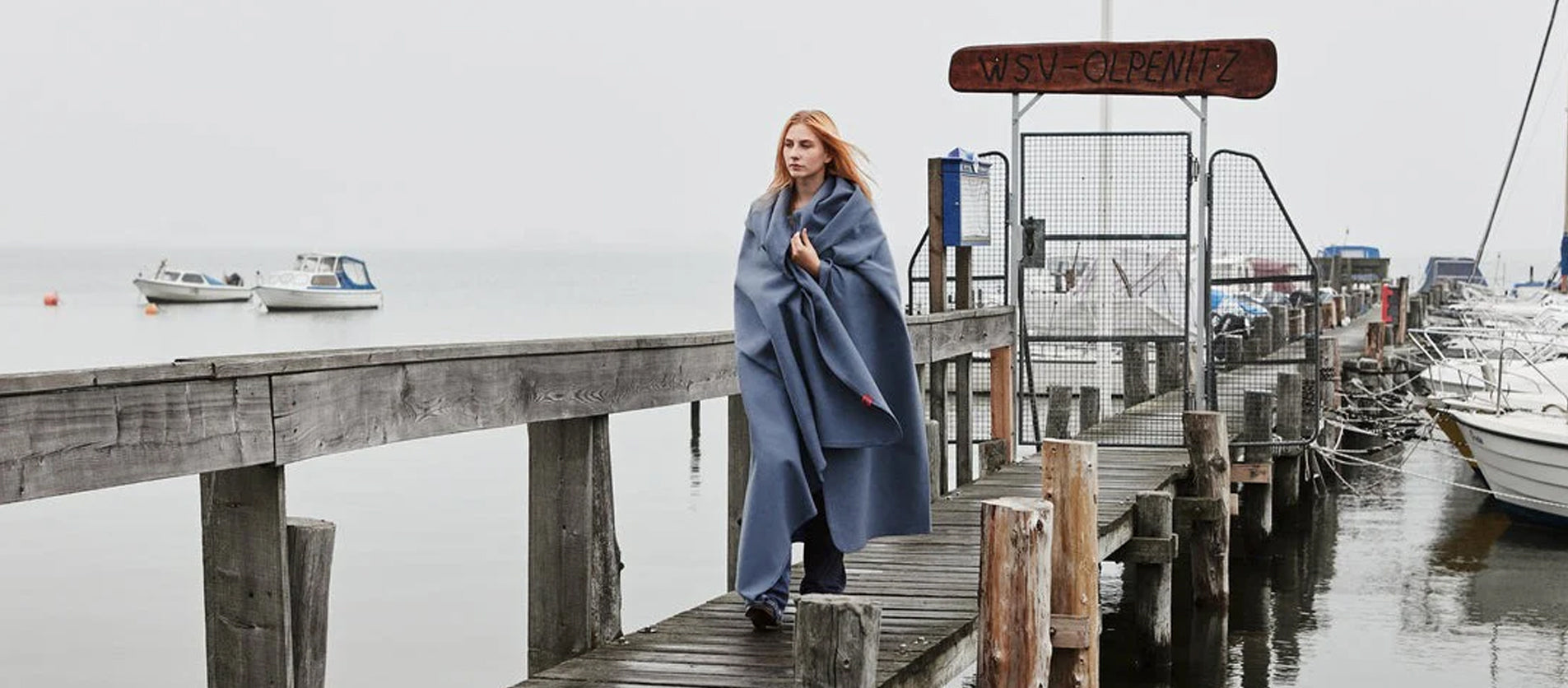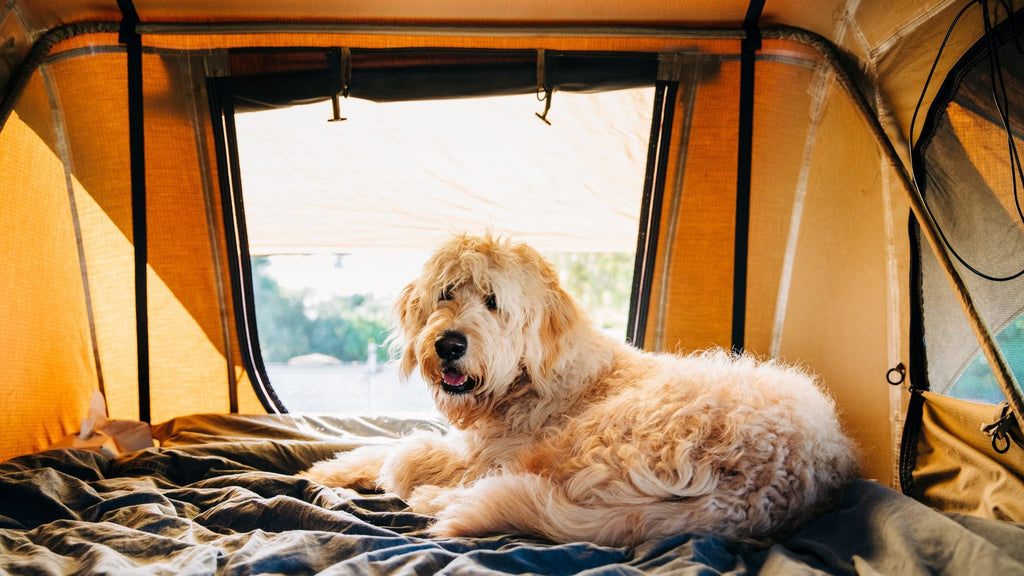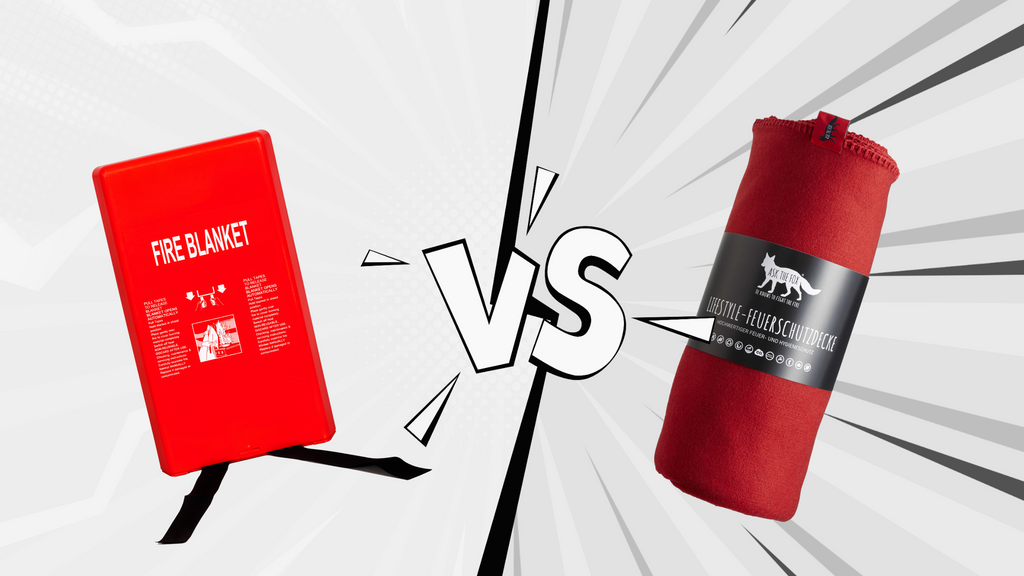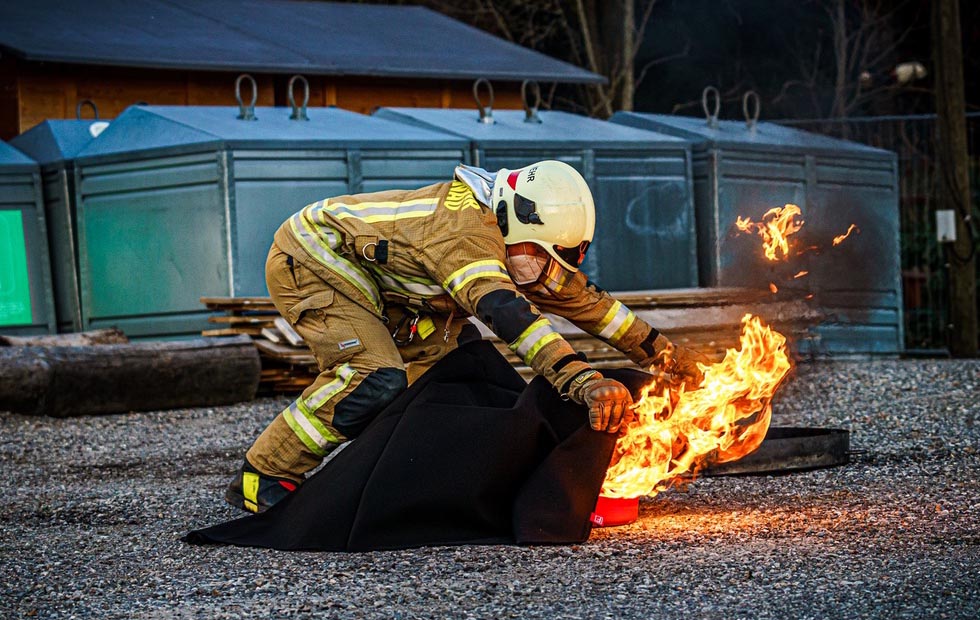Outdoor Blog
Fire Hazards in Outdoor Life
Whether you're camping, sailing, or enjoying a cozy backyard barbecue – it's not just the romantic atmosphere that draws us in. Sparks from campfires, embers from charcoal grills, or gas appliances used on yachts and in motorhomes can quickly lead to a fire. It becomes particularly dangerous when flames spread due to wind or improper handling. But with the right safety measures and smart fire protection, you can enjoy a safe summer outdoors.Protection from Fire and Cold – With the Right Equipment
In addition to a fire extinguisher, which can be invaluable in an emergency, a fire blanket is an excellent alternative for quickly smothering smaller fires. Because what if the fire extinguisher isn’t within reach or even causes damage, as can happen with foam or powder extinguishers? That’s where this solution comes in: a fire blanket that also doubles as a practical and cozy companion for cooler evenings outdoors. One such all-rounder is the COSY FOX. This blanket, made from the modern high-tech fiber PyroTex®, is not only exceptionally soft, snuggly, and hypoallergenic, but also fire-resistant. It reliably extinguishes flames and protects against embers and heat – without dripping, melting, or releasing harmful gases. As an added bonus, it keeps you warm and comfortable on chilly evenings, making it the perfect accessory for any outdoor adventure.Essential Safety Measures for a Safe Summer
To ensure your summer isn’t interrupted by unpleasant surprises, it’s important to follow a few basic safety precautions. You’ll find a checklist with key fire safety and outdoor tips here: Download Outdoor ChecklistSome important reminders:
- Gas heaters and electrical appliances in motorhomes, yachts, or boats should be serviced regularly.
- When cooking with an open flame, always ensure a stable base and keep flammable items away.
- Flying sparks from campfires or grills can be especially dangerous in dry and windy conditions - always be mindful of wind direction and maintain a safe distance from flammable materials.
- And most importantly: restrictions on open flames in certain areas exist for a reason and must be followed.
Conclusion
Summer is the perfect time to enjoy nature – whether barbecuing, camping, or sailing. But outdoor fires also come with risks. The COSY FOX from ASK THE FOX offers a practical solution – a cozy and protective fire blanket that not only provides comforting warmth but also offers reliable fire protection. It’s the ideal companion for a safe summer outdoors. Find more information and valuable fire safety tips for the outdoors in our blog.Winter camping isn’t for the faint of heart—or is it? With the right preparation, it becomes an unforgettable adventure where you can enjoy the serenity of snow-covered landscapes and clear, starry skies. At the same time, winter brings unique challenges that you can easily overcome with the following tips.
1. The Right Gear: Your Foundation for Safety and Comfort
Without the right gear, winter camping can quickly turn unpleasant or even dangerous. Here are the essentials:
- Tent: A 4-season tent with good insulation and a sturdy design will protect you from wind and snow.
- Sleeping bag: A down or synthetic sleeping bag rated for sub-zero temperatures is a must.
- Sleeping pad: Opt for a sleeping pad with a high R-value to prevent cold seeping from the ground.
- Clothing: Multiple layers (layering system), a windproof jacket, hat, gloves, and warm socks are essential.
Pro Tip: Bring our COSY FOX blanket. Not only is it delightfully warm, but it’s also fireproof—perfect for cozy nights by the campfire or as an extra layer on or under your sleeping bag.
2. Staying Warm: Mastering the Art of Heating
- Campfire: Always start your fire in designated, safe areas. Keep fire extinguishing materials handy to protect your surroundings.
- Camping stove: Choose a gas stove that functions reliably even in freezing temperatures.
- Emergency warmth: Heat packs or hot water bottles can make all the difference on cold nights.
3. Food and Drinks: Fuel Up
- Cold temperatures demand more energy from your body. Plan calorie-rich meals to keep you energized, such as soups, stews, or pasta.
Pro Tip: Don’t forget to drink warm beverages regularly. Insulated flasks keep tea or coffee warm for longer.
4. Safety First: Fire and Avalanche Precautions
- Fire safety: In enclosed spaces like vans or RVs, never leave open flames or camping stoves unattended.
Our fireproof COSY FOX blanket offers an extra layer of peace of mind. - Avalanche risk: Check the weather and avalanche reports for your region before your trip and avoid high-risk areas.
5. Winter Activities: More Than Just Camping
Winter camping opens up opportunities to try outdoor activities like cross-country skiing, snowshoeing, or ice skating.
In the evenings, enjoy well-earned relaxation—wrapped in a warm blanket by the campfire or inside your RV.
6. Sustainability in Winter Camping
Leave nature as you found it:
- Take your trash with you.
- Use eco-friendly hygiene products.
- Choose campsites or locations that prioritize sustainability.
Conclusion: Adventure Meets Comfort
Winter camping offers a unique chance to experience nature in its quiet and rugged beauty. With the right gear, careful planning, and safety precautions, your adventure is sure to be a success. And with our fireproof COSY FOX blanket, you’ll stay not only protected but also wonderfully cozy—no matter how cold the nights get.
Pack your gear and head into the winter wilderness—it’s worth it!
Sustainable camping is becoming increasingly popular, especially among families and outdoor enthusiasts who want to enjoy nature while minimizing their ecological footprint. In this blog post, we will show you how to camp sustainably with small, practical steps.
1. What is Sustainable Camping?
Sustainable camping means minimizing your impact on nature while responsibly managing resources. It's about enjoying the beauty of the outdoors without causing harm. By camping sustainably, you're not only protecting the environment, but you're also forging a deeper connection with nature. Additionally, you'll have the chance to learn valuable skills and create unforgettable memories with your family.
Key concepts for sustainable camping
- Leave-No-Trace: leave no litter and keep nature clean.
- Eco-friendly gear: use products that are reusable, versatile, recyclable, and sustainably made.
- Sustainable Practices: this includes conserving water and energy and properly disposing of waste.
2. Planning and Preparation
Choosing a campsite
Select campsites that promote sustainable practices. Look for environmental certifications and support local providers who are committed to conservation.
Gear
Invest in high-quality, long-lasting gear. Especially recommended are products that have multifunctional features and are reusable.
Speaking of multifunctionality: Our fireproof blankets, like the COSY FOX blankets, are ideal for various uses. Not only are they flame-resistant, but they are also incredibly soft and versatile. Whether you use them to protect your clothing around the campfire, as a cozy picnic blanket, for insulation on cold nights, or in emergencies as an effective fire extinguisher, the COSY FOX blankets, made from 100% PyroTex®, always offer optimal protection and comfort.
Packing List: Create a list of essential sustainable camping items:
- Weatherproof tent
- reusable water bottles and containers
- first aid kit
- biodegradable soap and cleaning products
- fireproof blanket for safety and comfort
- sustainable foods that don't produce much waste
3. Eco-friendly equipment and materials
Fireproof Blanket with Comfort A fire protection blanket should be a must in every camping pack. The COSY FOX blanket is not only a real eye-catcher but also extremely practical. It is flame-resistant, and insulating, ideal for use around the campfire and other scenarios. It not only serves as a safety measure but can also be used as additional insulation or as a mat.
Insulating Materials
Use tents and sleeping bags made from insulating and sustainable materials. These will keep you warm while also reducing the need to consume additional resources.
4. Sustainable camping practices
Leave-No-Trace Follow these seven principles of Leave-No-Trace:
- plan ahead and prepare.
- travel and camp on durable surfaces.
- dispose of waste properly.
- leave the site as if you weren’t there
- minimize campfire impacts and use sustainable fire sources.
- respect wildlife.
- be considerate of other campers.
Proper waste management
Take all your trash with you and avoid single-use products. Use recyclable materials and compost organic waste when possible.
Water and energy conservation
Use water sparingly and take advantage of solar energy for lighting and other needs. Portable solar panels are a great addition for sustainable campers, especially those traveling by car or RV.
5. Cooking and eating outdoors
Sustainable food
Opt for local and organic food. These products are fresh and have a smaller ecological footprint.
Campfires
A campfire can create a magical atmosphere, but it must be handled responsibly. Use existing fire pits and keep the fire small. Ensure it's completely extinguished before going to sleep.
Cooking without waste
Plan meals that produce minimal waste. Use reusable containers and cutlery. An easy and delicious recipe could be a vegetable stir-fry prepared over the fire.
6. Activities for the whole family
Exploring Nature
Take the opportunity to explore and learn more about nature. Hiking, birdwatching, and nature photography are great activities that foster a connection with the natural world.
Education and Awareness
Encourage environmental awareness in children through playful activities. Crafting with natural materials or going on a treasure hunt in the forest is not only fun but also fosters an appreciation for nature.
Connection to Nature
Camping offers the perfect opportunity to deepen your bond with nature and recharge yourself. With the right preparation, you can enjoy the rest of your trip relaxed and allow yourself to be in the moment. Watch the stars, tell stories around the campfire, and enjoy the peace while creating new memories that will bring you back to that state of serenity.
7. Sustainability throughout the entire journey
Transportation
Choose eco-friendly transportation methods like trains, buses, or carpooling. If you're traveling by car, try to save fuel by driving efficiently and with multiple passengers.
Accommodation
Sustainable accommodations like eco-campsites or tiny houses are a great option. They often offer eco-friendly amenities and support conservation efforts.
Sustainable behaviour
Stick to sustainable practices on the go. Use reusable bags, avoid plastic, and support local businesses.
Sustainable camping is not only good for the environment but also enhances your camping experience. With the right preparation and gear, like our fireproof blanket consisting of 100% PyroTex®, you can enjoy nature safely and responsibly.
Now it’s your turn! Try these tips on your next camping trip and share your experiences with us. Let’s protect and enjoy nature together.
For more information and tips on sustainable camping, you can browse our blog or follow us on Instagram and Facebook.
We hope this guide has been helpful and provided you with valuable tips for your next adventure. Share this article with friends and family so they too can benefit from the advantages of sustainable camping!

Our Latest Posts
Fire Hazards in Outdoor Life
Whether you're camping, sailing, or enjoying a cozy backyard barbecue – it's not just the romantic atmosphere that draws us in. Sparks from campfires, embers from charcoal grills, or gas appliances used on yachts and in motorhomes can quickly lead to a fire. It becomes particularly dangerous when flames spread due to wind or improper handling. But with the right safety measures and smart fire protection, you can enjoy a safe summer outdoors.Protection from Fire and Cold – With the Right Equipment
In addition to a fire extinguisher, which can be invaluable in an emergency, a fire blanket is an excellent alternative for quickly smothering smaller fires. Because what if the fire extinguisher isn’t within reach or even causes damage, as can happen with foam or powder extinguishers? That’s where this solution comes in: a fire blanket that also doubles as a practical and cozy companion for cooler evenings outdoors. One such all-rounder is the COSY FOX. This blanket, made from the modern high-tech fiber PyroTex®, is not only exceptionally soft, snuggly, and hypoallergenic, but also fire-resistant. It reliably extinguishes flames and protects against embers and heat – without dripping, melting, or releasing harmful gases. As an added bonus, it keeps you warm and comfortable on chilly evenings, making it the perfect accessory for any outdoor adventure.Essential Safety Measures for a Safe Summer
To ensure your summer isn’t interrupted by unpleasant surprises, it’s important to follow a few basic safety precautions. You’ll find a checklist with key fire safety and outdoor tips here: Download Outdoor ChecklistSome important reminders:
- Gas heaters and electrical appliances in motorhomes, yachts, or boats should be serviced regularly.
- When cooking with an open flame, always ensure a stable base and keep flammable items away.
- Flying sparks from campfires or grills can be especially dangerous in dry and windy conditions - always be mindful of wind direction and maintain a safe distance from flammable materials.
- And most importantly: restrictions on open flames in certain areas exist for a reason and must be followed.
Conclusion
Summer is the perfect time to enjoy nature – whether barbecuing, camping, or sailing. But outdoor fires also come with risks. The COSY FOX from ASK THE FOX offers a practical solution – a cozy and protective fire blanket that not only provides comforting warmth but also offers reliable fire protection. It’s the ideal companion for a safe summer outdoors. Find more information and valuable fire safety tips for the outdoors in our blog.- Hot Liquids & Foods – Spilled tea or coffee, hot soups, or porridge can cause scalds quickly. Water at 60°C can cause serious injuries in just a few seconds.
- Stove & Oven – Children are curious and might touch hot stove plates or the oven door.
- Iron & Hair Dryer – These devices often stay hot for a long time after use and are easily accessible to children.
- Candles, Matches & Lighters – Little children are fascinated by flames and may reach for them.
- Power Outlets & Electrical Devices – A faulty hairdryer or a plugged-in charging cable can cause dangerous electrical burns.
- Sunburn – Excessive UV exposure is also a burn, which can be especially dangerous for babies.
- Fireworks & Sparklers – Even small firecrackers or sparklers can cause severe burns.
- Keep hot drinks & food out of reach – Never place cups on tablecloths or coffee tables.
- Install stove guards & turn pots to the back – This prevents children from accidentally touching a hot pot or pan.
- Make the bathroom safe – A scald protection for the shower or bathtub prevents water that’s too hot. The ideal temperature is a maximum of 37°C.
- Put away electrical devices after use – Don’t leave curling irons, straighteners, or irons unattended.
- Childproof electrical outlets – Special outlet covers prevent children from inserting objects.
- Store lighters & matches securely – They should never be in the hands of children.
- Take sun protection seriously – Babies should not be exposed to direct sunlight. Use UV clothing and sunscreen with high SPF.
- Explain fire safety playfully – Even toddlers can learn that "hot" is dangerous.
- Stay calm and reassure your child – Your child will sense your panic, so take deep breaths.
- Remove clothing, but only if it’s not stuck to the skin!
- Cool with lukewarm water (about 20°C, not ice cold!) – At least 10 minutes under running water. Ice or cold water can cause further damage to the skin.
- Unusual but effective: Urine – Urine contains urea, which cools and protects the skin. For contact burns (e.g., from hot water or an object, but no open wounds), fresh urine can be applied for 15–30 seconds. Important: Urine is only effective if applied immediately after the burn. Clean the area with lukewarm water afterward. Post-application is ineffective. For more serious burns, always seek a doctor!
- Don’t use home remedies! – Butter, flour, or toothpaste will only worsen the wound.
- Cover with sterile dressings – A burn should be covered with a sterile compress or, if necessary, with cling film.
- "Cold water always cools effectively." – Water that's too cold can cause hypothermia and interfere with the healing process.
- "Ice or cooling compresses relieve the pain." – Ice can cause frostbite and further damage the skin.
- "Cover wounds with a bandage." – Dry bandages can stick to the wound and delay healing.
- "Open burn blisters for faster healing." – Blisters protect the wound from infection and should not be opened on their own.
- "Home remedies like butter or flour help." – These substances worsen the wound and promote infections.
- Fire-extinguishing cuddle blanket – Safety meets comfort.
- Sustainable materials – Our blankets are made from PyroTex® fibers, which are free from harmful substances.
- Prevention as a lifestyle – Safety can be stylish and practical.
Well Prepared for the Festive Season
The “great days” are just around the corner! Whether it's a Fastnacht session, a private party, or the grand carnival parade—wherever celebrations take place—both small and large hazards may be lurking. To help you safely navigate the fifth season, we have compiled twelve simple yet effective safety tips.
- Do not wear masks or costumes made of highly flammable material. When purchasing streamers and garlands, look for fire-resistant products. You can identify them by the “B1” marking.
- When decorating your party room, do not place decorative materials in close proximity to light bulbs, heaters, candles, or other hot objects.
- Be cautious with open flames in decorated spaces. Arrange candles and lanterns in a way that keeps them safe from the revelry.
- Provide ashtrays and dispose of their contents only into metal buckets.
- Clearly mark emergency exits and ensure they remain unobstructed.
- Keep fire extinguishing equipment handy: fire extinguishers, fire blankets, or buckets of water.
- Inform yourself in advance and during the event about the weather conditions. Smartphone apps like NINA or KatWarn are just as useful as the German Weather Service app.
- Even though the chase for “Kamelle” and other thrown items can get intense—maintain a safe distance from parade floats. Pay special attention to children!
- Enjoy alcohol in moderation. Accidents and illnesses caused by intoxication are the most common reasons for emergency medical services deployments at festive events—such as falls resulting in cuts from broken glass.
- Park responsibly and keep emergency routes clear!
- Many fire departments volunteer to help manage and secure carnival parades. Please support these emergency personnel by not interfering with their work.
- Whether it’s a fire, traffic accident, or a medical emergency: alert the fire brigade by dialing the free emergency number 112.
Winter camping isn’t for the faint of heart—or is it? With the right preparation, it becomes an unforgettable adventure where you can enjoy the serenity of snow-covered landscapes and clear, starry skies. At the same time, winter brings unique challenges that you can easily overcome with the following tips.
1. The Right Gear: Your Foundation for Safety and Comfort
Without the right gear, winter camping can quickly turn unpleasant or even dangerous. Here are the essentials:
- Tent: A 4-season tent with good insulation and a sturdy design will protect you from wind and snow.
- Sleeping bag: A down or synthetic sleeping bag rated for sub-zero temperatures is a must.
- Sleeping pad: Opt for a sleeping pad with a high R-value to prevent cold seeping from the ground.
- Clothing: Multiple layers (layering system), a windproof jacket, hat, gloves, and warm socks are essential.
Pro Tip: Bring our COSY FOX blanket. Not only is it delightfully warm, but it’s also fireproof—perfect for cozy nights by the campfire or as an extra layer on or under your sleeping bag.
2. Staying Warm: Mastering the Art of Heating
- Campfire: Always start your fire in designated, safe areas. Keep fire extinguishing materials handy to protect your surroundings.
- Camping stove: Choose a gas stove that functions reliably even in freezing temperatures.
- Emergency warmth: Heat packs or hot water bottles can make all the difference on cold nights.
3. Food and Drinks: Fuel Up
- Cold temperatures demand more energy from your body. Plan calorie-rich meals to keep you energized, such as soups, stews, or pasta.
Pro Tip: Don’t forget to drink warm beverages regularly. Insulated flasks keep tea or coffee warm for longer.
4. Safety First: Fire and Avalanche Precautions
- Fire safety: In enclosed spaces like vans or RVs, never leave open flames or camping stoves unattended.
Our fireproof COSY FOX blanket offers an extra layer of peace of mind. - Avalanche risk: Check the weather and avalanche reports for your region before your trip and avoid high-risk areas.
5. Winter Activities: More Than Just Camping
Winter camping opens up opportunities to try outdoor activities like cross-country skiing, snowshoeing, or ice skating.
In the evenings, enjoy well-earned relaxation—wrapped in a warm blanket by the campfire or inside your RV.
6. Sustainability in Winter Camping
Leave nature as you found it:
- Take your trash with you.
- Use eco-friendly hygiene products.
- Choose campsites or locations that prioritize sustainability.
Conclusion: Adventure Meets Comfort
Winter camping offers a unique chance to experience nature in its quiet and rugged beauty. With the right gear, careful planning, and safety precautions, your adventure is sure to be a success. And with our fireproof COSY FOX blanket, you’ll stay not only protected but also wonderfully cozy—no matter how cold the nights get.
Pack your gear and head into the winter wilderness—it’s worth it!
Brand Highlights
German Design Award Winner 2023
In the category of "Excellent Product Design“
The German Design Award is the premium award presented by the German Design Council. With its global scope and international prestige, it is one of the most esteemed awards in the world of design, spanning across various industries. Since 2012, the German Design Award has identified significant design trends, showcased them to a wide audience, and recognized outstanding achievements in product design, communication design, and architecture.
All awards are determined during a two-day jury session. The jury for the German Design Award 2023 comprises experts from eleven different nationalities, representing professionals from the fields of business, academia, and design industry. All jury members are recognized authorities in their respective fields.
We are immensely proud to announce that ASK THE FOX has won the German Design Award 2023 in the category of "Excellent Product Design" for our Lifestyle Fire Blanket.
The First Fabric Firefighter
ASK THE FOX is the world's first fire blanket with a cuddle factor, designed for use at home and on the go. At first glance, it appears as a stylish blanket for sofas, beds, and children's rooms. On closer inspection, it reveals itself as a highly professional fire protection blanket that you'll want to have within easy reach by the fireplace, at a campfire, in your car, tent, camper, or on a sailing yacht. All our blankets are so comfortable that they can even be used as warming cuddle blankets for babies. ASK THE FOX blankets do not catch fire, melt, or drip, they produce no toxic gases, and are antibacterial, antifungal, and antiviral.
Fire blankets are a proven tool to extinguish fires before they spread. They belong in every kitchen and near areas where fires may start. However, not all fire blankets are the same — this becomes evident when comparing conventional fire blankets with innovative alternatives like the COSY FOX fire protection blanket. Below, we highlight the key differences between standard hardware store options and the COSY FOX fire protection blanket to help you decide which one is best for your home.
1. Material: Fiberglass vs. PyroTex®
Common fire blankets found in hardware stores are often made of fiberglass. While affordable and heat-resistant, fiberglass has drawbacks when handled. It can irritate the skin and is uncomfortable to touch, which could make its use more difficult during an emergency. Additionally, it is not designed for regular use or comfort.
In contrast, the COSY FOX fire protection blanket is made from a specially developed fiber that is not only extremely fire- and heat-resistant but also soft and pleasant to touch. PyroTex® fibers are inherently flame-resistant, meaning these properties are built into the material's structure and aren’t added through chemical treatments. As a result, the fire protection properties remain effective live-long without losing their efficiency.
2. Applications: Emergency-Only Product vs. Everyday Companion
A typical fire blanket from the hardware store is a dedicated emergency product. It’s usually stored in a box or packaging and is only brought out when a fire occurs. In daily life, it’s not used or noticed.
The COSY FOX blanket, however, offers real value in everyday life. Its soft, cozy texture means it can be used as a regular blanket — whether on the couch, in bed, or while camping. In an emergency, it functions just as effectively as a fire blanket, offering the same, if not better, protection than conventional models. This makes it a multifunctional product that combines safety with comfort.
3. Heat Resistance and Protection
While standard fire blankets have a certain level of heat resistance, the COSY FOX blanket, with its innovative PyroTex® fibers, offers much higher protection. PyroTex® fibers withstand temperatures up to 1,000°C without melting or emitting toxic fumes. This is particularly important in emergencies, as it minimizes the risk of secondary hazards from melting materials or poisonous gases.
Conventional fiberglass blankets, on the other hand, can become brittle or disintegrate at extremely high temperatures, reducing their effectiveness in critical situations.
4. Durability and Care
Another key difference lies in the durability and maintenance of the blankets. Fiberglass fire blankets can become brittle over time, especially when exposed to moisture or mechanical stress. They should therefore be regularly inspected and possibly replaced. The COSY FOX blanket, in contrast, is extremely durable and low-maintenance. It retains its protective properties for years without becoming brittle or losing its shape. Plus, it’s machine washable, adding to its everyday convenience.
5. Sustainability and Environmental Considerations
The production of fiberglass blankets is energy-intensive and harmful to the environment. Furthermore, fiberglass is difficult to recycle and often leaves microparticles in the environment.
ASK THE FOX, on the other hand, focuses on sustainability. The unique PyroTex fiber is recyclable, and its production is more energy-efficient compared to conventional fiberglass products. This demonstrates that the COSY FOX fire blanket not only excels in safety but also leads in terms of environmental protection.
Conclusion: Safety Meets Comfort
The main difference between a conventional fire blanket from the hardware store and a COSY FOX fire protection blanket lies in the combination of safety and everyday usability. While standard blankets are designed solely for emergency use, the COSY FOX blanket provides protection and comfort in daily life.
It is soft, durable, sustainable, and maintains its excellent protective properties over time. If you’re looking for an innovative, multifunctional solution for increased safety at home, the ASK THE FOX fire protection and fire blanket is the right choice.
Everything You Need to Know About Lifestyle Fire Blankets.
Fire is a formidable force. Its unpredictable nature and its ability to cause damage or destruction make fire safety a top priority in natural environments as well as in residential, commercial, and industrial areas. One simple yet effective fire safety tool is the fire blanket.
A fire blanket is a safety device used to extinguish small fires or protect individuals from flames. It is made from fire-resistant material, often fiberglass or PyroTex®, capable of withstanding high temperatures. When used correctly, a fire blanket can smother a fire by depriving it of the oxygen it needs to burn.
Fire blankets Fire blankets can not only extinguish small fires but also serve as a "protective shield" to escape from a fire. Wrapping a person in a fire blanket can help prevent severe burns by creating an insulating layer against the heat. This feature makes them a potentially life-saving tool in various situations.
Another crucial application of fire blankets is combating kitchen fires, especially grease fires. Unlike water, which can worsen a grease fire, a fire blanket can safely smother it. This versatility and adaptability make fire blankets an essential fire safety tool recommended by international safety experts.
In the following sections, we will delve deeper into the nature of fire blankets and explore their operation, types, benefits, usage limitations, and the correct way to use them to provide you with a comprehensive understanding of this life-saving device.
What Makes a Fire Protection Blanket a Lifestyle Fire Blanket?
Lifestyle Fire Blanket is a safety tool specifically designed to extinguish initial fires. It is made entirely of PyroTex®, a fire-resistant material, and is simply placed over a fire to smother it.
The primary purpose of a lifestyle fire blanket is to interrupt the oxygen supply to the fire, thereby stopping the combustion process. This method of fire suppression is particularly effective for small fires, such as those that can occur in a kitchen. In some cases, these fire blankets can also be used as protective coverings for individuals trapped by a fire, helping to get them to safety.
Lifestyle fire blankets withstand very high temperatures, a feature attributed to the PyroTex® material. This allows them to effectively and safely smother many small fires at their source.
In general, the size of a fire blanket can vary depending on its intended use. For example, fire blankets for large kitchens or industrial environments are typically larger than those intended for household use.
While fire blankets are relatively simple in terms of design and operation, their effectiveness in combating and controlling fires is undeniable. They are an essential part of fire safety equipment at home, during leisure activities, or in various workplaces.
This also applies to lifestyle fire blankets, which have an additional advantage: as the name suggests, they can also serve as decorative elements. A design piece that you simply enjoy having around, both visually and as a cozy source of warmth. And that means that in case of emergency, the blanket is immediately at hand, making it an indispensable element of safety precautions in homes, schools, restaurants, and many other places.
Types of Fire Blankets
Fire Blanket come in various sizes, materials, and designs, depending on their intended use or application. Being informed about these variations and differences can help you choose the most suitable fire blanket for your specific needs.
- Fire Blankets for Residential Buildings: These are typically smaller, often in a 1 m x 1 m format, and designed for household use. They are ideal for combating small kitchen fires, electrical fires, or fires caused by appliances.
- Commercial Fire Blankets: Commercial fire blankets are larger and designed for more extensive fires, such as those that may occur in restaurants, labs, or industrial facilities. They typically have dimensions of 1.2 m x 1.8 m or more.
- Industrial Fire Blankets: These blankets are designed for extreme use and can withstand extremely high temperatures. They are used in high-risk fire environments, such as welding or cutting operations in industry.
- Emergency Fire Protection Blankets: These fire blankets are larger and intended to protect individuals. In the event of a fire, people can wrap themselves in these blankets as a protective cover to escape from a burning building.
- Specialized Fire Blankets: These include fire blankets designed for specific purposes, such as for car or boat fires or for use in theaters and other large public spaces.
- Wildfire Fire Blankets: Some fire blankets are specifically designed for combating wildfires. They are large enough to protect people and buildings and can withstand the intense heat of a wildfire.
Fire Blanket are typically made from fiberglass or PyroTex®, both materials known for their excellent heat resistance. However, some industrial-use fire blankets may also contain additional materials like asbestos-free amorphous silicon dioxide, which can handle even higher temperatures.
When selecting the right fire blanket, factors such as potential fire risks, the environment of use, and ease of use in emergencies should be considered. Always remember that while fire blankets are an important fire safety option, they are by no means a substitute for a fire extinguisher or other firefighting methods.
How Do Fire Blankets Work?
To understand the mechanism of a fire blanket, one must be familiar with the basic principle upon which every fire is based: the so-called fire triangle. A fire requires three elements to sustain itself: fuel, heat, and oxygen. The fire is extinguished when one of these elements is removed or significantly reduced. Fire blankets primarily work by interrupting the oxygen supply, thus eliminating one corner of the fire triangle, causing the fire to extinguish.
Here is a detailed explanation of how they work:
Smothering the Fire: Fire blankets are designed to completely cover the fire and create a barrier between the fire and the oxygen in the air. Once the blanket is placed over the flames, it cuts off the oxygen supply. Without oxygen, the fire lacks the fuel needed to continue burning, and it extinguishes.
Heat Isolation: Fire blankets are made of fire-resistant materials like fiberglass or PyroTex® that have excellent insulating properties. When a fire blanket is placed over a fire, it interrupts the oxygen supply and traps the heat. This prevents the fire from spreading or causing further damage.
Protecting the Fuel: By covering the fire, the blanket also separates the flames from nearby fuel sources, preventing the fire from spreading to other flammable materials.
It's important to know that while fire blanketcan be extremely useful in extinguishing small fires or providing a protective barrier during evacuation, they are not suitable for fighting large, uncontrollable fires. In such situations, it is essential to evacuate the area immediately and call the fire department (emergency number 112).
Understanding the scientific fundamentals of how a fire blanket works underscores and clarifies its importance as a fire safety tool. A fire blanket can quickly and efficiently extinguish fires and prevent further damage or injuries by disrupting the fire triangle.
Uses of Fire Blankets
Fire blankets are characterized by a wide range of applications, providing a versatile solution for fire protection. Depending on the specific requirements of a situation, different types of fire blankets can be used. Here are some common scenarios for their use:
Home Use:
In private households, fire blanket are typically used for small fires that can occur in the kitchen or other parts of the home. For example, a kitchen fire caused by oil or grease can be quickly and safely extinguished with a fire blanket. These blankets can also be used to extinguish fires from small appliances or electrical systems. Additionally, they can reliably prevent domino effects caused by burning candles or sparks from the fireplace, not to mention their use as cozy and decorative blankets.
Industrial Use:
Industries such as metalworking, welding, and manufacturing employ fire blankets to combat fires resulting from various processes. Industrial fire blankets are designed to withstand extremely high temperatures and can effectively smother large fires. They are crucial for worker safety in high-risk environments.
Emergency Use:
Fire blankets can be used in emergency situations to protect individuals from flames and heat. During a fire evacuation, wrapping oneself in an emergency fire protection blanket can provide critical protection against burns and smoke inhalation.
Wildfire Protection: In areas prone to wildfires, specially designed wildfire fire blankets can be used to protect buildings and property. These blankets are large and heat-resistant, providing a barrier against advancing flames.
Transportation: Fire blankets designed for use in vehicles and boats can help control fires that may occur in these environments. They are compact and easy to store, making them suitable for travel.
The versatility of fire blankets makes them an essential tool for fire safety, both in preventing fires from spreading and protecting individuals in emergencies. However, it's crucial to select the appropriate type of fire blanket for the specific environment and potential fire risks.
Limitations of Fire Blankets
While fire blankets are effective tools for extinguishing small fires and providing temporary protection, they have certain limitations that should be considered:
Limited Fire Size:
Fire blankets are most effective on small fires, such as those involving small appliances, kitchen fires, or clothing fires. They may not be suitable for larger or more intense fires, which should be addressed by professional firefighters using appropriate equipment.
Limited Coverage: The size of a fire blanket determines the area it can cover. Larger fires may require multiple blankets or other firefighting methods.
Personal Protection: Fire blankets can be used to protect individuals during evacuation, but they may not provide complete protection against extremely high temperatures or smoke inhalation. In such cases, evacuation should be the top priority.
Not Suitable for Chemical Fires: Fire blankets are generally not recommended for fires involving chemicals or hazardous materials. Using the wrong type of blanket in such situations can be dangerous.
Proper Training Required: To effectively use a fire blanket, individuals should be trained in its proper deployment and safety procedures. Improper use can lead to injuries.
One-Time Use: Fire blankets are typically designed for single-use only. Once used to extinguish a fire, they should not be reused.
Limited Duration: Fire blankets can provide temporary protection. However, individuals should not rely solely on a fire blanket for long-term fire safety. Evacuation and professional firefighting services are essential in the event of a significant fire.
It's important to remember that fire blankets are just one component of a comprehensive fire safety plan. Fire extinguishers, smoke detectors, fire alarms, and evacuation plans are equally crucial for ensuring safety in different settings.
How to Use a Fire Blanket Safely
Using a fire blanket effectively and safely requires proper technique and knowledge. Here are step-by-step instructions on how to use a fire blanket:












